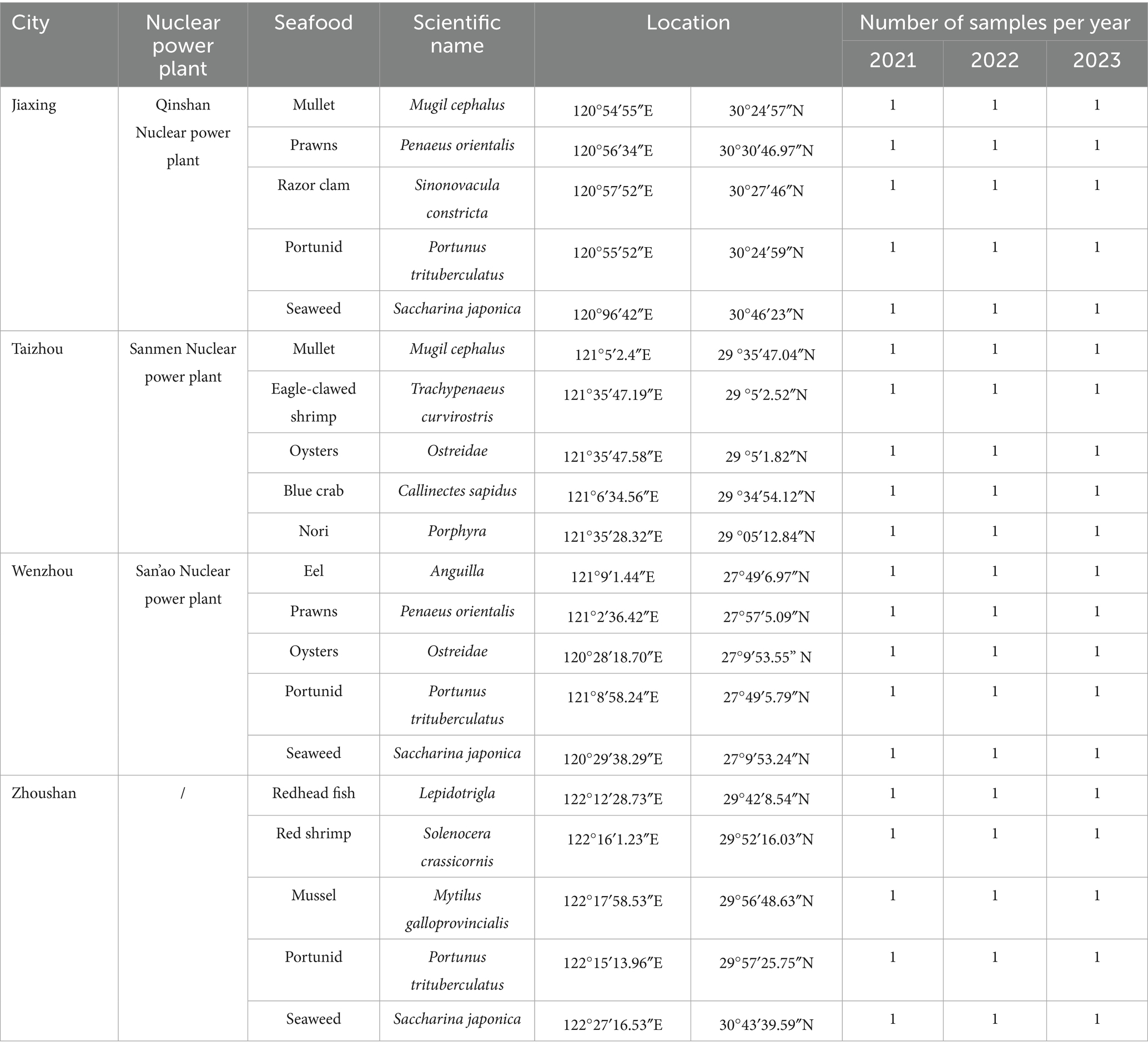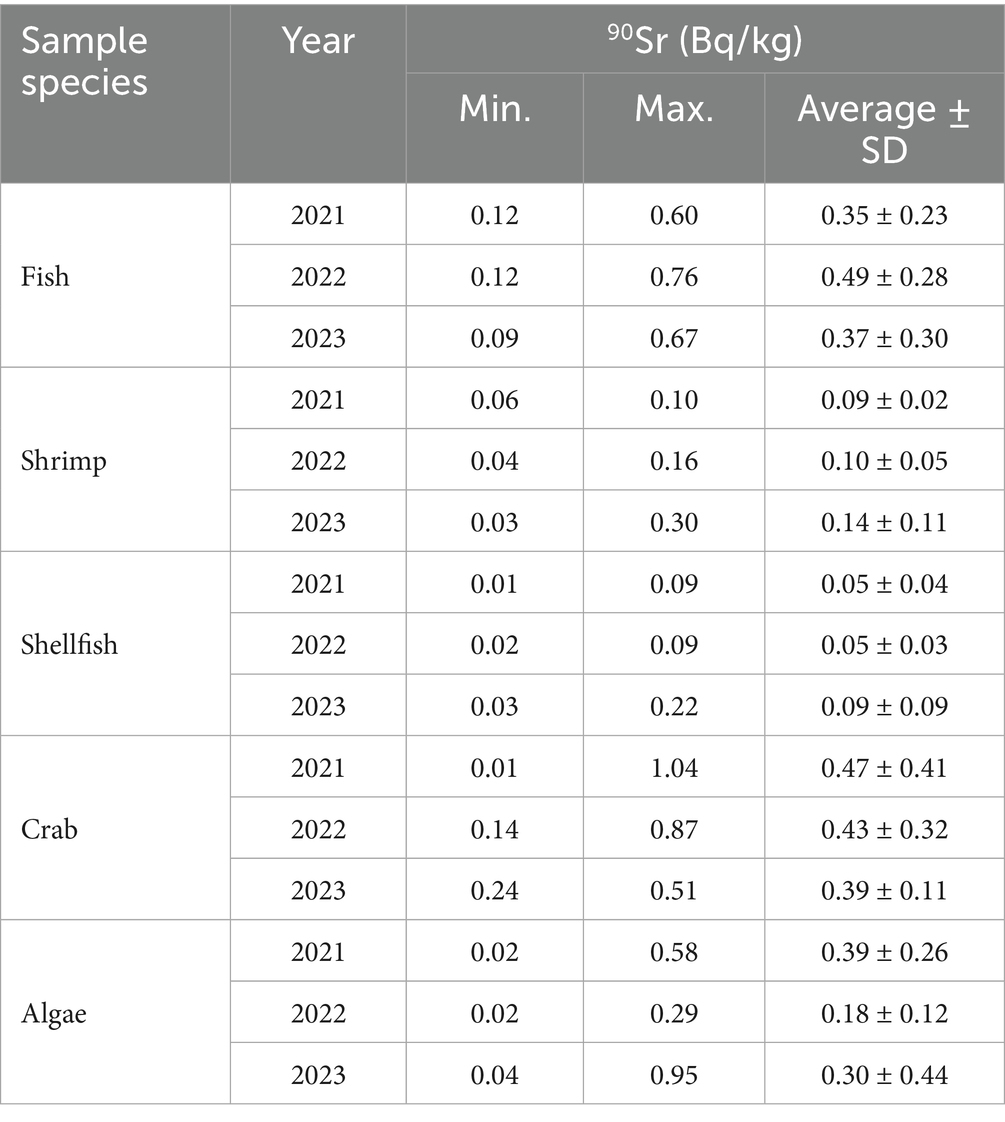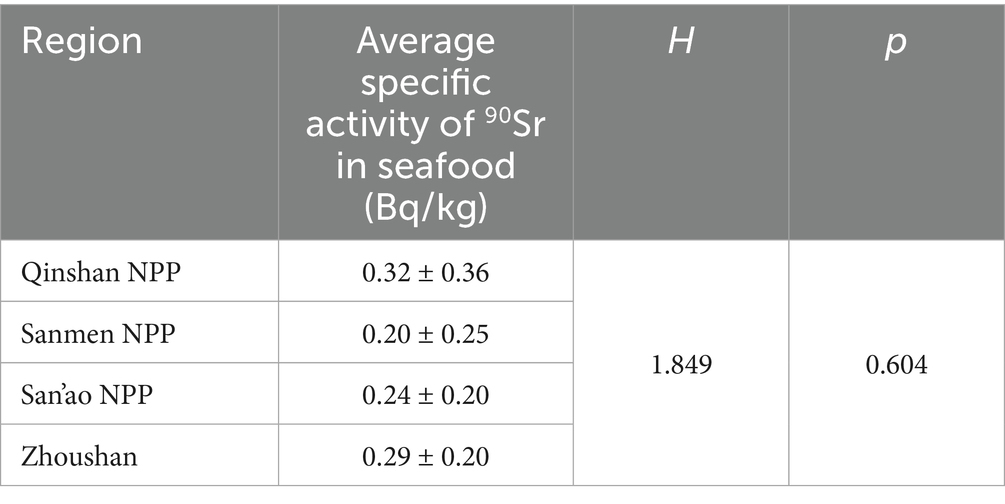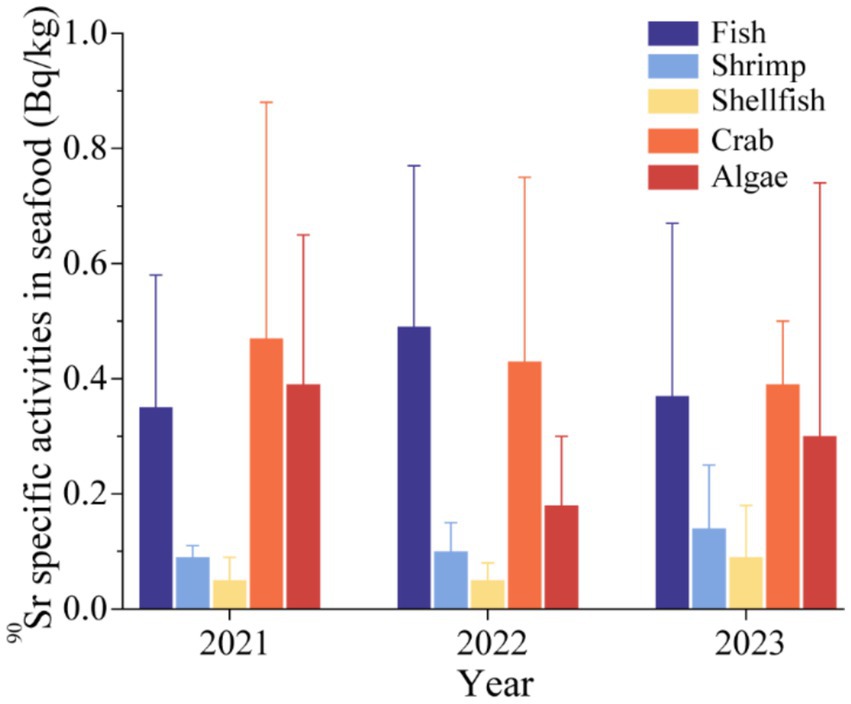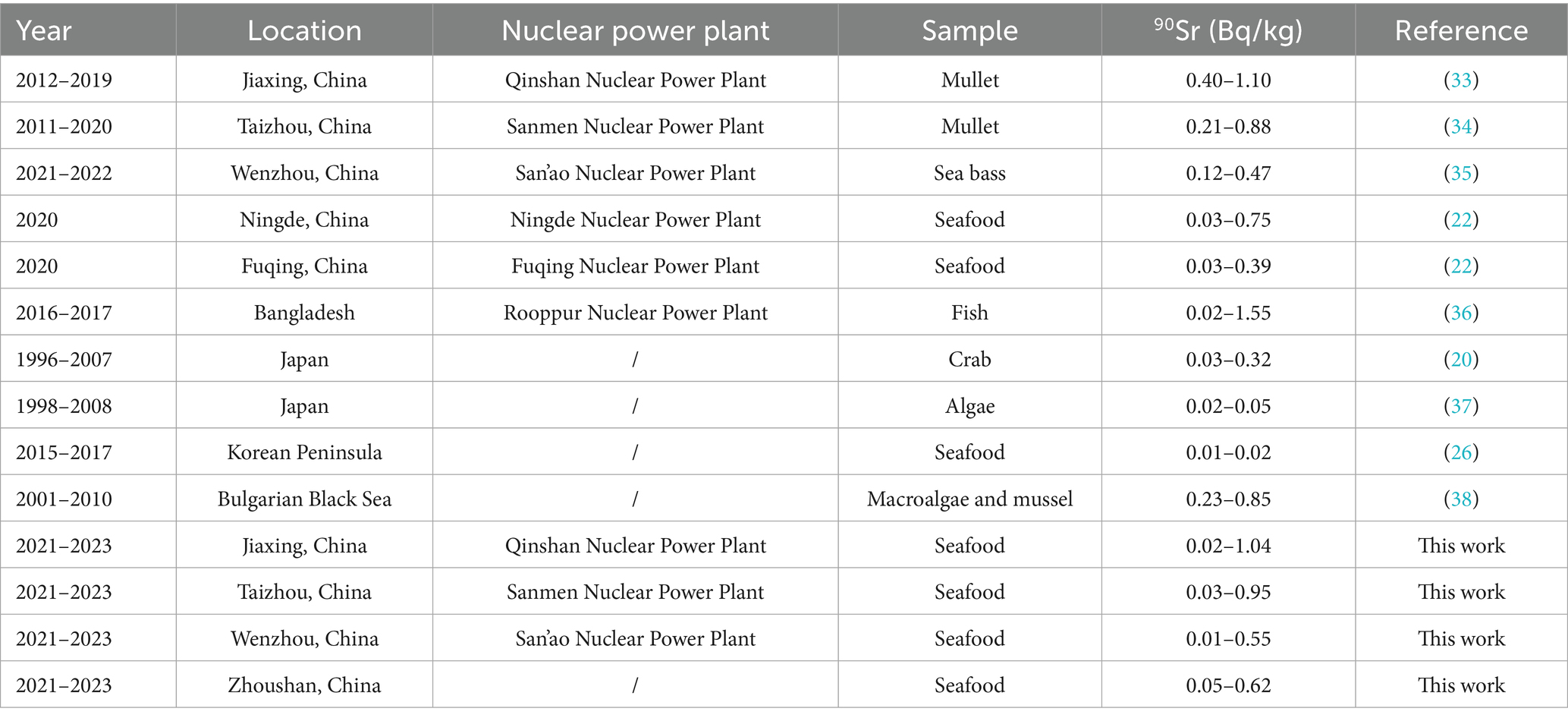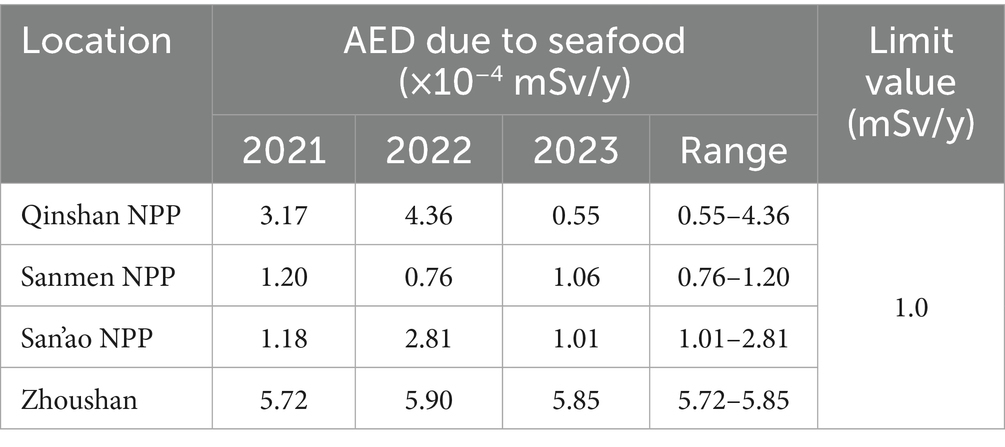- 1Department of Occupational Health and Radiation Protection, Zhejiang Provincial Center for Disease Control and Prevention, Hangzhou, Zhejiang, China
- 2School of Public Health, Suzhou Medical College, Soochow University, Suzhou, China
Objective: This work aims to assess the impact of three nuclear power plants (NPPs) in Zhejiang Province on the levels of 90Sr in surrounding seafood, and to evaluate the associated health risks, providing a scientific basis for operational monitoring and contributing essential baseline data for nuclear emergency preparedness.
Methods: From 2021 to 2023, the specific activities of 90Sr in five types of seafood (fish, shrimp, mussels, crabs, and algae) were monitored in the three NPPs, compared with Zhoushan City, which has no NPP, and the annual effective dose (AED) was estimated.
Results: The results show that the mean specific activities of 90Sr in fish, shrimp, mussels, crabs, and algae around the NPPs were found to range from 0.09 to 0.76 Bq/kg, 0.03–0.30 Bq/kg, 0.01–0.22 Bq/kg, 0.11–1.04 Bq/kg, and 0.02–0.95 Bq/kg, respectively. According to the Kruskal-Wallis test, there was no statistically significant difference between the 90Sr specific activities in seafood from the three NPPs and Zhoushan. The AED due to 90Sr intake from seafood for residents living around the three NPPs and Zhoushan are much lower than the recommended threshold of 1.0 mSv/y.
Conclusion: The comprehensive monitoring results demonstrated that the 90Sr levels were at background levels and remained stable, consistently well below the limits of the relevant food safety standards, and the dose burden on the population was slight, indicating that the operation of the NPPs in Zhejiang Province did not have a significantly impact on the local seafood.
1 Introduction
In the wake of the Fukushima Daiichi nuclear power plant (FDNPP) incident, there has been a notable shift in focus toward not only the major radionuclides released into the environment, but also toward some minor yet highly radiotoxic radionuclides (1), including 90Sr. Indeed, following the significant discharges from the FDNPP site in 2011, ongoing releases of 90Sr to the marine environment in the form of highly radioactive wastewater have been reported (2).
Given its potential for significant harm, 90Sr is among the radionuclides most closely monitored in the event of a severe nuclear accident or nuclear release (3). 90Sr has a relatively long half-life (T1/2 = 28.8 y) (4), high radio-toxicity, and maintains a high degree of mobility and persistence in the environment (5). Consequently, it is considered to be one of the most potentially hazardous and toxic artificial radionuclides in the environment (6–8). Furthermore, 90Sr can be taken up by seafood, and eventually enter the human body via the food chain (9). Since the chemical property of 90Sr is similar to calcium and its affinity for tissues rich in calcium content like bones and teeth, it can persist within the body for over a decade, leading to significant internal radiation-induced damage (10–14).
Zhejiang Province is located in the southern region of the Yangtze River Delta, with the east of the East China Sea. Due to its strategic coastal location, Zhejiang Province hosts three nuclear power plants, namely Qinshan Nuclear Power Plant (Qinshan NPP), Sanmen Nuclear Power Plant (Sanmen NPP) and San’ao Nuclear Power Plant (San’ao NPP). It is worth noting that the Qinshan NPP is the first nuclear power station independently researched, designed, and constructed by China (15). Sanmen NPP represents the world’s first AP1000 passive safety nuclear power unit (16). San’ao NPP employs China’s self-developed third-generation nuclear power technology “Hualong One” (HPR1000), which possesses independent intellectual property rights (17). As a province with three NPPs, monitoring their operation is particularly critical.
On the other hand, given that Zhejiang Province is home to China’s largest fishing ground, Zhoushan Fishing Ground, thereby contributing to the national seafood supply chain, seafood has become an integral part of the diet of the majority of the population in Zhejiang Province, providing the population with high-quality proteins and essential amino acids (18). The seafood consumption of Zhejiang residents accounts for a considerable proportion in China’s per capita seafood consumption (19). However, 90Sr can enter the body through ingestion of seafood by the population, resulting in internal exposure. Therefore, the radioactivity monitoring of 90Sr in seafood around nuclear power plants in Zhejiang Province is of great significance. This effort will help determine whether the operation of these NPPs has caused radioactive contamination in coastal marine organisms and whether the consumption of such seafood poses health risks to local residents.
It is notable that there have been few investigations into the specific activity of 90Sr in seafood around nuclear power plants in Zhejiang Province. This is due to the considerable technical challenge presented by the necessity for chemical processing and separation in order to determine the levels of pure β-emitters (7). Meanwhile, existing literature reports typically focus on monitoring the specific activity of 90Sr in a single type of seafood, rather than conducting systematic testing across multiple seafood categories (20). In this study, we presented the specific activities of 90Sr in various seafood species surrounding three NPPs as well as an area of non-nuclear facilities in Zhejiang Province from 2021 to 2023. Based on the time-series observation data, the annual effective dose (AED) was estimated in order to clarify the changing law of seafood radioactivity levels in Zhejiang Province and ensure the safety and security of the food supply. Furthermore, this work provides both a scientific basis for operational monitoring and critical baseline data for nuclear emergency preparedness.
2 Materials and methods
2.1 Sample collection
In this work, fish, shrimp, shellfish, crab and algae were selected around nuclear power plants in Zhejiang Province in 2021–2023. Moreover, to facilitate a more accurate comparison of 90Sr activity levels, the city of Zhoushan City was selected as the control point for seafood monitoring. This city does not possess a nuclear power plant and has a high consumption of seafood. Each of the five types of seafood around the NPP and in Zhoushan was collected once a year and used for 90Sr detection. The relevant regions and detailed sampling information of seafood are shown in Figure 1 and Table 1.
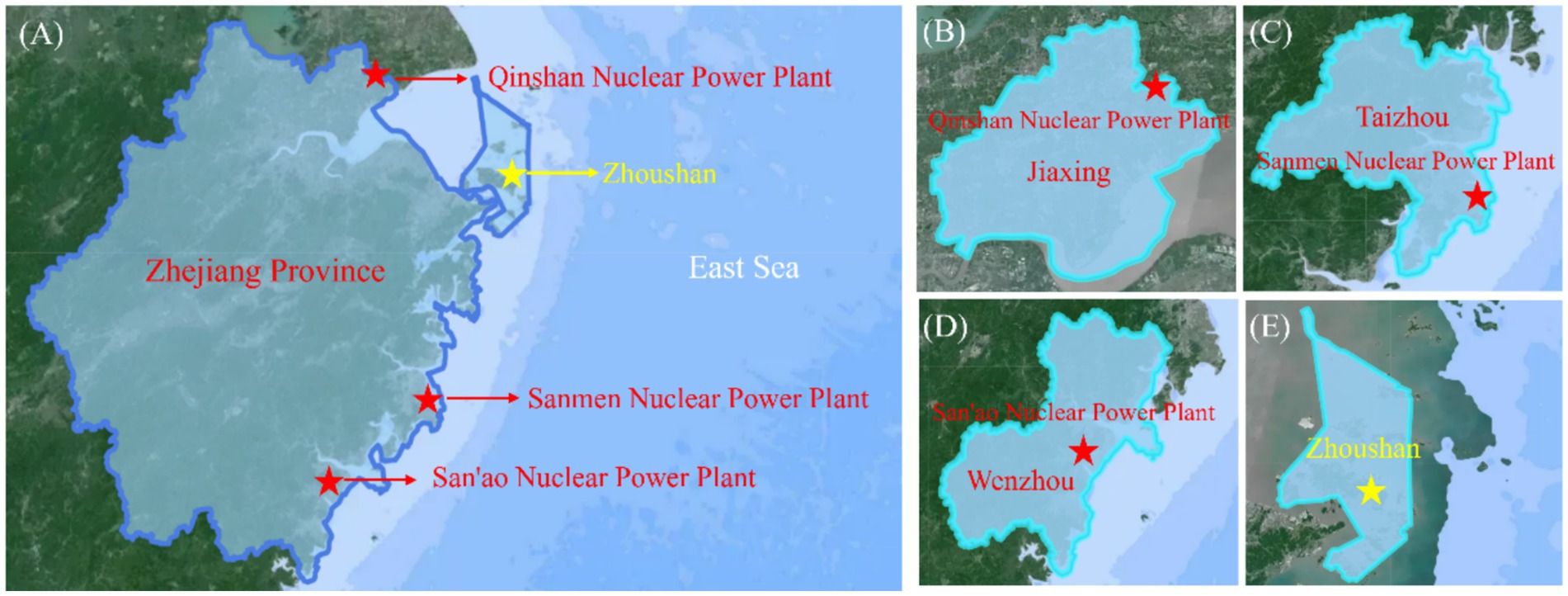
Figure 1. (A) Distribution of monitoring sites in Zhejiang Province and the location of cities of (B), (B) Qinshan Nuclear Power Plant, (C) Sanmen Nuclear Power Plant, (D) San’ao Nuclear Power Plant, and (E) Zhoushan, the control site.
2.2 Reagents and instruments
The following chemicals were used in the experiment: SrCl2·6H2O and Y(NO3)3·6H2O (Shanghai Macklin Biochemical Technology Co., Ltd.); Bi(NO3)3·5H2O (Sinopharm Chemical Reagent Co., Ltd.); sodium sulfide, hydrochloric acid, hydrogen peroxide, and nitric acid (Shanghai Lingfeng Chemical Reagent Co., Ltd.), absolute ethanol (Anhui Ante Food Co., Ltd.), oxalic acid (Changshu Yonghua Chemical Technology (Jiangsu) Co., Ltd.), ammonia solution (Hangzhou Longshan Fine Chemicals Co., Ltd.), and di-(2-ethylhexyl)phosphoric acid (60–80 mesh, Beijing Research Institute of Chemical Engineering and Metallurgy, CNNC). The water used in this experiment complies with the Grade 2 water standards specified in GB/T 6682-2008, and all reagents used were of analytical grade.
Low background total α and total β measuring instrument (LB790 ten-way low background αβ measuring instrument, Germany Berthold Technologies), graphite hot plate (HTL-400EX, NanoHeat), muffle furnace (DC-B125/13, Beijing Original Technology Co., Ltd.), electronic balance (AE 200, Mettler Toledo Instruments (Shanghai) CO. Ltd.), drying oven (Binder, Binder Environmental Test Equipment (Shanghai) Co., Ltd.), centrifuge (5810, Eppendorf, Germany).
2.3 Sample pre-treatment
All seafood was processed without delay following its arrival at the laboratory, having been transported in a frozen state. The procedure involved washing, selecting edible portions, draining and weighing the samples, which were then placed in an oven at 105°C for drying. After drying, they were carbonized and ashed in a muffle furnace to decompose the organics, a process which requires step-segmental warming. The maximum temperature was maintained at 500°C during the ashing of the samples. Once the ashing process was complete, the sample ash was allowed to cool to room temperature and weighed again in order to obtain the weight of the ash sample and the ash-fresh ratio. In this work, none of the 90Sr analytical procedures involved composite samples, and all of our experimental subjects were individual specimens.
2.4 Procedure for 90Sr analysis of samples
For sample preparation, 5–10 g of sample ash was placed in an evaporation dish, followed by 0.5 mL of strontium carrier (50 mg/mL) and 1 mL of yttrium carrier (20 mg/mL). Then 10 mL of HNO3 and 6 mL of H2O2 were added to remove organic matter and impurities, and after evaporation on a graphite hot plate, the samples were transferred to a muffle furnace at 600°C for calcination for 2–3 h. Once the sample had cooled to room temperature, it was leached with 2 mol/L hydrochloric acid solution (40 mL × 2) and centrifuged at 4,000 rpm for 5 min to retain the supernatant. Subsequently, the residue was washed two times with deionized water and the supernatant was mixed with the previous supernatant, which was retained in a beaker. 10 g of oxalic acid was added to the mixture, and the pH of the solution was adjusted to 2.5 with ammonia. The precipitate was collected by filtration, and then transferred to a muffle furnace for calcination at 800°C for 1 h. The product was completely dissolved with 6 mol/L nitric acid, followed by the addition of 1.0 mol/L HNO3, bismuth carrier (20 mg/mL) and 0.3 mol/L sodium sulfide solution, the insoluble matter was filtered out, the filtrate was collected, and its pH was adjusted to 1.
The pretreated filtrate was passed through the Di-(2-ethylhexyl) phosphoric acid (HDEHP) column, and washed with 1.0 mol/L hydrochloric acid (30 mL) at a controlled flow rate of 1.5 s/drop, then rinsed with 1.5 mol/L nitric acid (40 mL). Finally, the filtrate was collected into a Teflon beaker with 6 mol/L nitric acid (30 mL) at a flow rate of 3 s/drop.
The saturated oxalic acid solution (5 mL) was added to the eluent, and its pH was adjusted to 2.5 with ammonia. After aging, the eluate was filtered to produce the precipitate. The dried precipitate was taped to the sample tray and determined with the low background α-β counter, counting 10 cycles of 100 min each.
2.5 Calculation of 90Sr specific activity
The specific activity of 90Sr in seafood was calculated using the following formula:
where C is the specific activity of 90Sr, Bq/kg; Ns is the net count rate of the sample, min−1; M is the ash freshness ratio, g/kg; ŋ is the instrumental efficiency, %; W is the sample ash, g; YY is the yttrium chemical recovery, %; λ is the decay constant of 90Y; and t is the intermediate moment from the separation of 90Sr, 90Y to the measurement, h.
2.6 Estimation of annual effective dose (AED)
The radioactivity produced by ingestion accumulates in the body and affects the body’s tissues and organs over a long period of time, causing varying degrees of internal radiation damage (21–23). The annual effective dose (AED, mSv/y), as a radiation protection quantity, is considered an effective tool for radiation exposure risk assessment (15). The resident intake of seafood can be calculated on the basis of the frequency and quantity of seafood consumed by the population, allowing for the estimation of AED.
The AED associated with internal exposure through seafood consumption was calculated by the following equation:
where ISr is the respective annual intake of 90Sr in seafood (Bq/y), e(g)Sr is the age-dependent dose conversion coefficient for ingestion of 90Sr (2.8 × 10−8 Sv/Bq).
Referring to the relevant literature on the status of annual consumption of seafood by residents of coastal and island areas in Zhejiang Province (24), the annual per capita consumption of fish, shrimp, shells, crabs and seaweeds for the whole population was shown in Table 2.
2.7 Quality assurance
Prior to utilizing the LB790 ten-channel low background αβ counter to detect the sample, the electroplating source of 90Sr–90Y with radioactivity intensity of 1.20 × 103 (Number of particles on the surface/2π·min) inspection and standard source scale were employed, and the background measurement cycle and measurement time were consistent with the actual detection of the sample. All instruments utilized were qualified within the verification cycle. The 90Sr–90Y standard solution (9.78 Bq/g of 90Sr in 0.1 mol/L nitric acid) was added to the blank sample for pretreatment and detection, and the discrepancy between the detection results and the reference value of the reference material was within 10%. Ten percent of the samples were taken for parallel sample analysis, and the relative standard deviation of the measured values of the parallel samples was within 10%. The analysts are certified to work, regularly participate in on-site quality control, and the experimental data are accurate and reliable.
3 Results and discussion
3.1 Specific activity of 90Sr in different seafood
The specific activities of 90Sr in five types of seafood consumed by residents of Zhejiang are presented in Table 3. The results of the three-year monitoring demonstrate that the specific activities of 90Sr in the five types of seafood sampled around the NPP have remained stable and have not undergone significant change. The mean specific activities of 90Sr in fish, shrimp, shellfish, crabs, and algae in the vicinity of the nuclear power plant were found to range from 0.09 to 0.76 Bq/kg, 0.03–0.30 Bq/kg, 0.01–0.22 Bq/kg, 0.11–1.04 Bq/kg, and 0.02–0.95 Bq/kg, respectively, which were much lower than the national standards for specific activity of 90Sr in seafood and close to the results reported by other literature (25–28). It is noteworthy that 90Sr specific activities were significantly higher in fish and crab compared to the other three types of seafood, whereas 90Sr specific activities in shellfish were at a lower level, due to the removal of the shells of the shellfish samples used in this study, taking into account the osteophilic nature of 90Sr and the fact that it accumulates in the shells of bivalves, together with calcium (29). In comparison to other seafood products, crabs possess a relatively low muscle content. Consequently, during the processing of crabs, the shells were retained, while the inedible parts were removed. However, the main component of crab shells is chitin which bonds calcium strongly (20). Due to the similar chemical properties of strontium and calcium, strontium may be bound to crab shells, leading to the higher specific activity of 90Sr in crabs. Moreover, 90Sr is metabolized slowly in fish tissues; the effective half-life of 90Sr in fish is about 500 days and up to 97% of 90Sr is present in fish tissues such as bones, scales, and gills (30). On the other hand, fish and crabs are at a higher trophic level in the food chain compared to the other three types of seafood. As a result, fish and crab exhibit higher 90Sr specific activity.
In this study, the specific activities of 90Sr in different types of seafood (fish, shrimp, shellfish, crab, and algae) monitored from 2021 to 2023 were analyzed by the Kruskal-Wallis test and the results are presented in Table 4 and Figure 2. The results demonstrated statistically significant differences (p < 0.001) in the 90Sr radioactivity levels of the five seafood species. A comparison of any two groups of the five seafood products revealed that the p-values between fish and shellfish, crab and shellfish, shrimp and crab were all less than 0.05. In particular, the p-values between fish and shellfish, crab and shellfish were all less than 0.001, indicating that there were significant differences in the specific activities of 90Sr radioactivity in these groups of seafood. The source of these differences may be due to the different environmental conditions under which the biota grows, as well as to differences in the selectivity and accumulation of 90Sr for different types of foodstuffs.
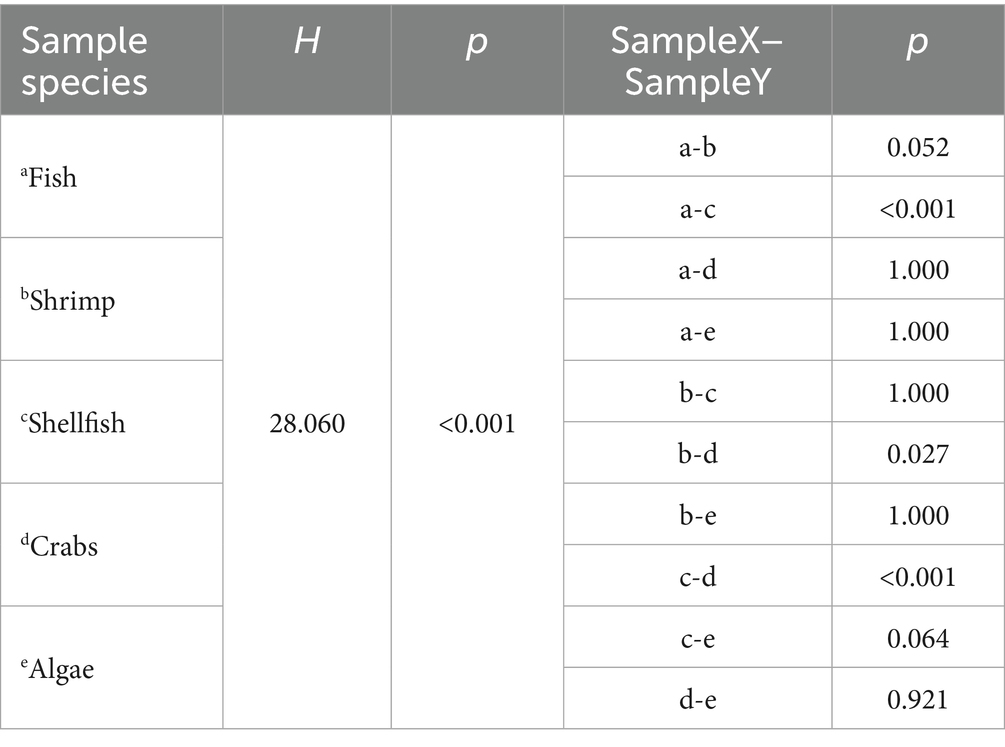
Table 4. Comparison of 90Sr specific activity in different kinds of seafood in Zhejiang Province from 2021 to 2023.
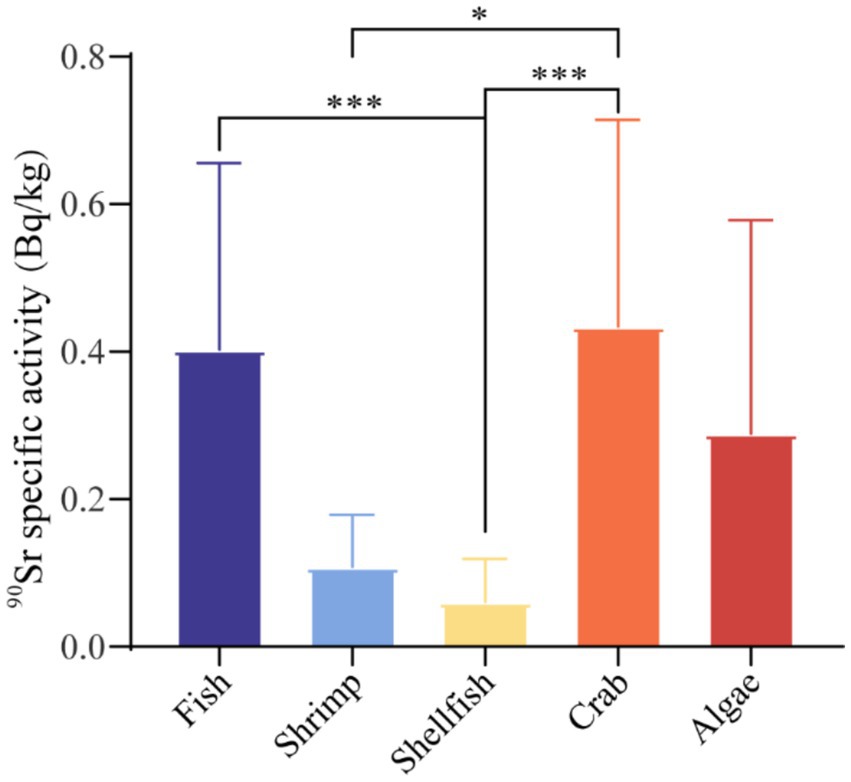
Figure 2. Specific activity of 90Sr in different types of seafoods in Zhejiang Province. *p < 0.05, ***p < 0.001.
3.2 Specific activity of 90Sr in seafood around different locations
Seafood is considered to be an important source of protein for people living near nuclear power plants. From the monitoring of seafood from Qinshan NPP, Sanmen NPP, San’ao NPP and the control site Zhoushan, it can be found that the 90Sr specific activities of seafood around each nuclear power plant fluctuate normally within the background level and are close to those of the control site Zhoushan from 2021 to 2023, as shown in Figure 3A. A comprehensive investigation was conducted to assess the levels of 90Sr in various seafood types at multiple monitoring points (Figure 3B). The findings revealed that the specific activities of 90Sr in all seafood categories were markedly below the established limit value, as defined by the national standard. The 90Sr specific activity in shrimp and shellfish around Zhoushan is higher than in the other three NPPs. This can be attributed to the unique geographical location of the Zhoushan fisheries at the confluence of the Yangtze River, Yong River and Qiantang River and the estuary of the three rivers (31), has turned the waters of Zhoushan into an important outlet for radionuclides from the Yangtze River, resulting in the accumulation of certain radionuclides in seafood. On the other hand, Zhoushan Fishery is known for its rich biodiversity. The area is shaped by complex interactions of ocean currents and topography, creating a habitat that is favorable for a wide range of marine organisms. It serves as a vital spawning and feeding ground for a multitude of shrimp species (32). It was also observed that there were minor fluctuations in the specific activities, which were attributed to a number of objective factors, including fluctuations in the detection instruments and changes in background levels. However, it was noted that the specific activities remained at the background level and did not exhibit any significant increase.
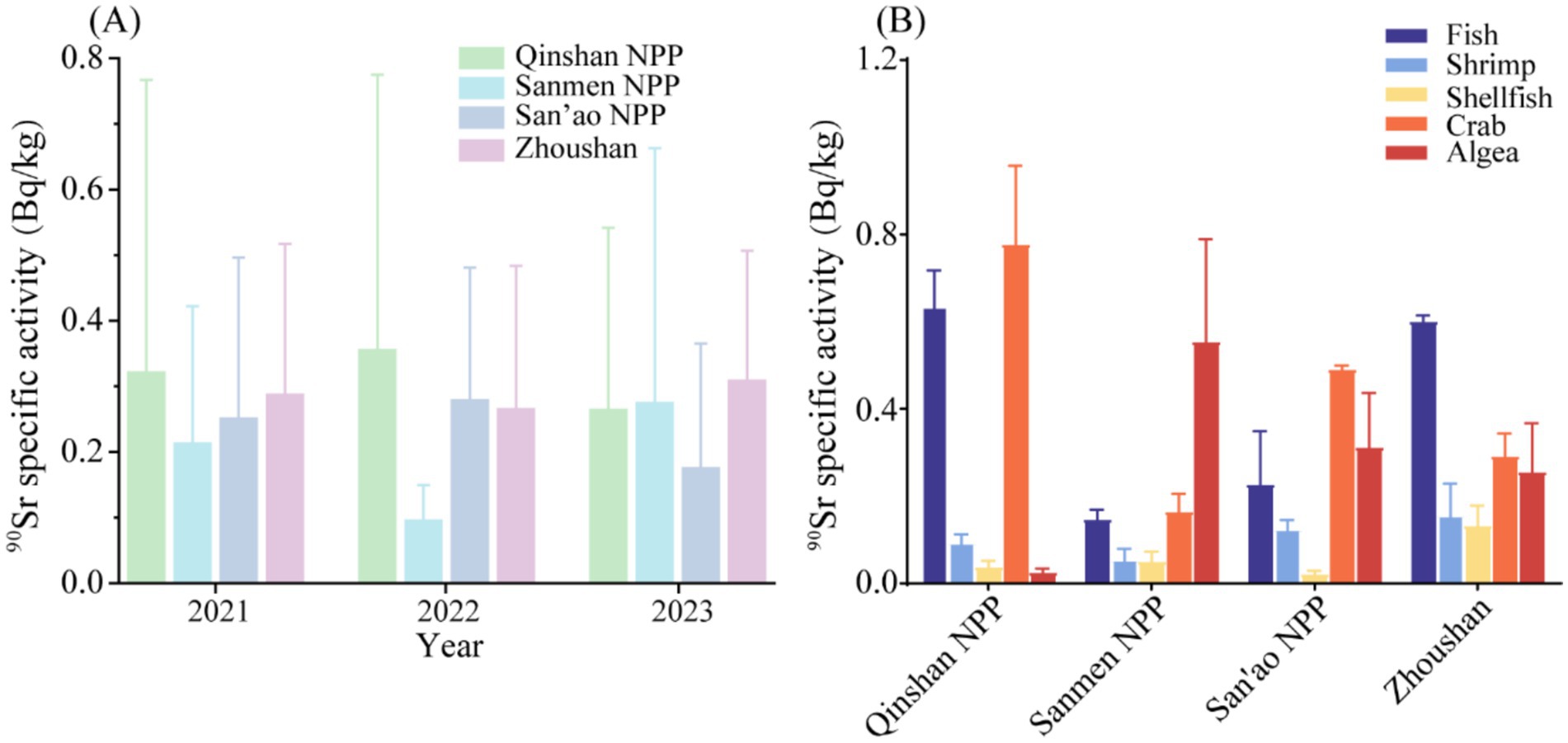
Figure 3. (A) Specific activities of 90Sr in seafood from various locations in different years; (B) Specific activities of 90Sr in different types of seafood from different locations.
The statistical analyses (Kruskal-Wallis test) of the three NPPs and the control site demonstrated that the specific activities of 90Sr in seafood from disparate locations were analogous (Table 5). Furthermore, no significant difference was observed (p > 0.05), which provides additional evidence that the three nuclear power plants were operating stably.
3.3 Specific activities of 90Sr in seafood from different years
The specific activities of 90Sr in the five types of seafood monitored in different years are presented in Figure 4. The results demonstrate that there was no significant inter-annual variation in the levels of 90Sr radioactivity in the five types of seafood during the three-year period, and that the results exhibited a tendency toward stability. The Kruskal-Wallis test was carried out to analyze the 90Sr specific activities of fish, shrimp, shellfish, crab and algae over the period from 2021 to 2023. The results demonstrated no statistically significant difference (p > 0.05), as illustrated in Table 6. This finding indicates that there was no notable alteration in specific activities of 90Sr among the five seafood types between 2021 and 2023. Furthermore, the specific activities of 90Sr remained stable and remained below the national standard limits. This indicates that the nuclear power plant operated in an effective and environmentally responsible manner, with no discernible adverse effects on marine life.
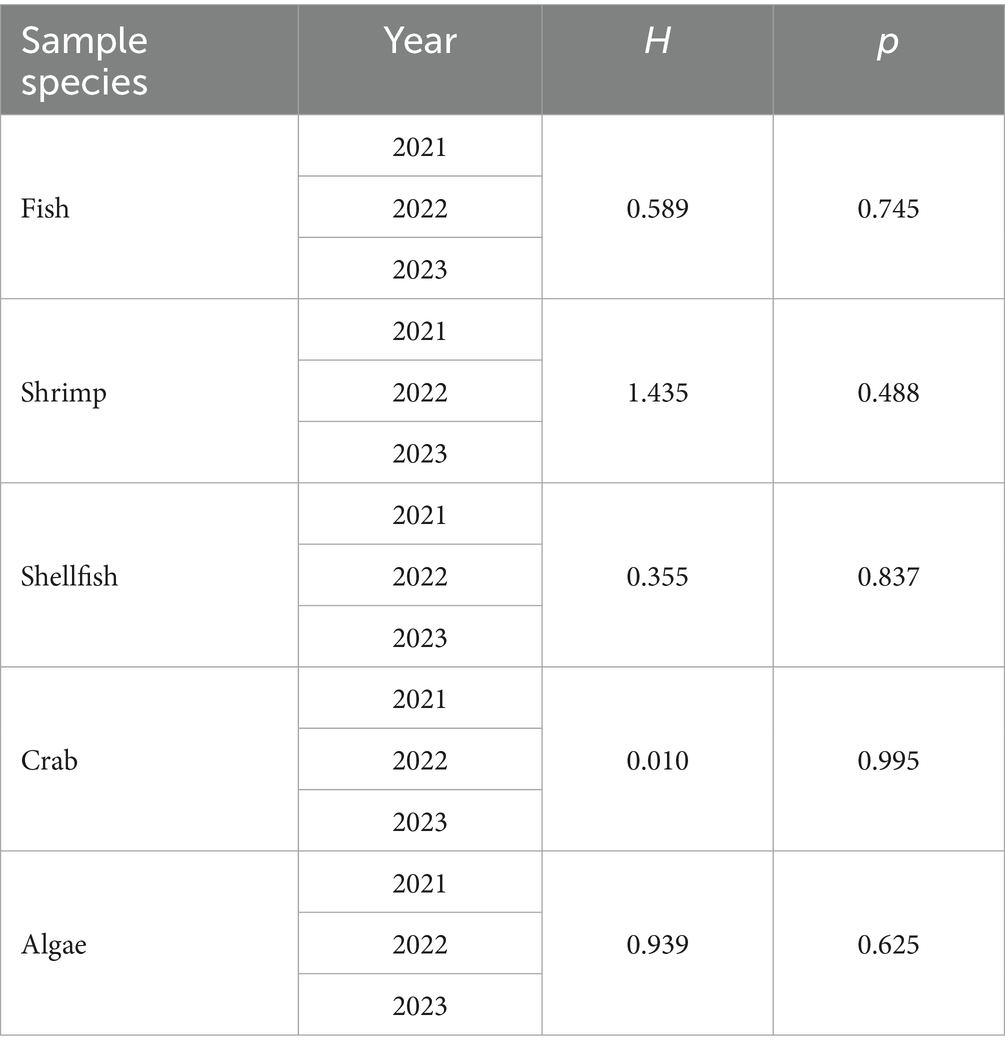
Table 6. Comparison of the trends of 90Sr specific activities in five types of seafood in Zhejiang Province between 2021 and 2023.
Our team has been engaged in a prolonged period of research, with the objective of monitoring the 90Sr specific activity in foodstuffs in the vicinity of three nuclear power plants in Zhejiang Province (33–35), as shown in Table 7. Furthermore, the specific activities of 90Sr in seafood detected in 2020 at the Ningde and Fuqing nuclear power plants, which are located in close proximity to the latitude and longitude of the three nuclear power plants in Zhejiang Province, ranged from 0.03 to 0.75 Bq/kg and 0.03–0.39 Bq/kg, respectively (22). The specific activities of 90Sr in fish around Rooppur Nuclear Power Plant in the People’s Republic of Bangladesh, which is also on the Asian plate, ranged from 0.02 to 1.55 Bq/kg (36). The results of this study for 90Sr specific activity in seafood did not exhibit a significant change when compared to the results of the team’s previous monitoring and monitoring results around other nuclear power plants. Furthermore, the 90Sr specific activity we observed in seafood were similar to those reported in the global monitoring studies (20, 26, 37, 38), indicating stable operation of nuclear power plants in Zhejiang Province.
3.4 Dose assessment
Based on the survey of relevant literature on the annual consumption status of seafood by residents of coastal cities in Zhejiang Province (24), the AED due to the intake of 90Sr from a single type of seafood by the residents around the nuclear power plant and Zhoushan City in 2021–2023 was estimated, as shown in Figure 5. It is noteworthy that among the five categories of seafood, marine fish contributed the largest AED, which may be associated with the dietary habits of residents of Zhejiang Province, where fish has the highest annual per capita consumption. Additionally, this can be attributed to the practical considerations for residents, for whom fish is more readily accessible. From 2021 to 2023, the AED due to individual types of seafood in the vicinity of the three nuclear power stations and Zhoushan remained at a stable level, with no significant fluctuations observed. Furthermore, the AED accumulated from total seafood consumption over the period from 2021 to 2023 was estimated (Table 8). The results demonstrated that the AED due to total seafood at Qinshan Nuclear Power Station, Sanmen Nuclear Power Station, San’ao Nuclear Power Station and Zhoushan were 0.55 × 10−4 to 4.36 × 10−4 mSv/y, 0.76 × 10−4 to 1.20 × 10−4 mSv/y, 1.01 × 10−4 to 2.81 × 10−4 mSv/y, 5.72 × 10−4 to 5.85 × 10−4 mSv/y, respectively. The AEDs from seafood in Zhoushan City were higher than those in the three nuclear power plant regions of Zhejiang Province, primarily because Zhoushan is an island area, while the Qinshan NPP, Sanmen NPP and San’ao NPP are located in coastal areas—leading to distinct differences in seafood consumption habits. Furthermore, the Zhoushan city encompasses China’s largest fishing ground, Zhoushan Fishery, renowned for its high marine biodiversity and abundant fishery resources. This ecological advantage ensures greater accessibility of diverse seafood for local residents, leading to significantly higher seafood consumption compared to populations near nuclear power plants. Consequently, the AED attributed to seafood in Zhoushan exceeds that in the nuclear power plant vicinity. However, these values are considerably below the acceptable level of 1.0 mSv/y set by the International Commission on Radiological Protection (ICRP) for the general public, indicating that the dose burden on the population is slight and that the operation of the nuclear power stations has no discernible impact on public health. Furthermore, the anthropogenic radionuclide 137Cs appears in about 40% of seafood dose assessments due to its radiological significance in routine and accidental releases from nuclear facilities, its background presence due to global fallout and its relative ease of measurement (39). By comparing the AED due to 137Cs in seafood reported in the relevant literature (40), we found that the AED due to 90Sr in seafood monitored in this work is close to the reported value, which is consistent with the results reported by IEAE on the contribution to annual ingested dose from radionuclides in diet (41).
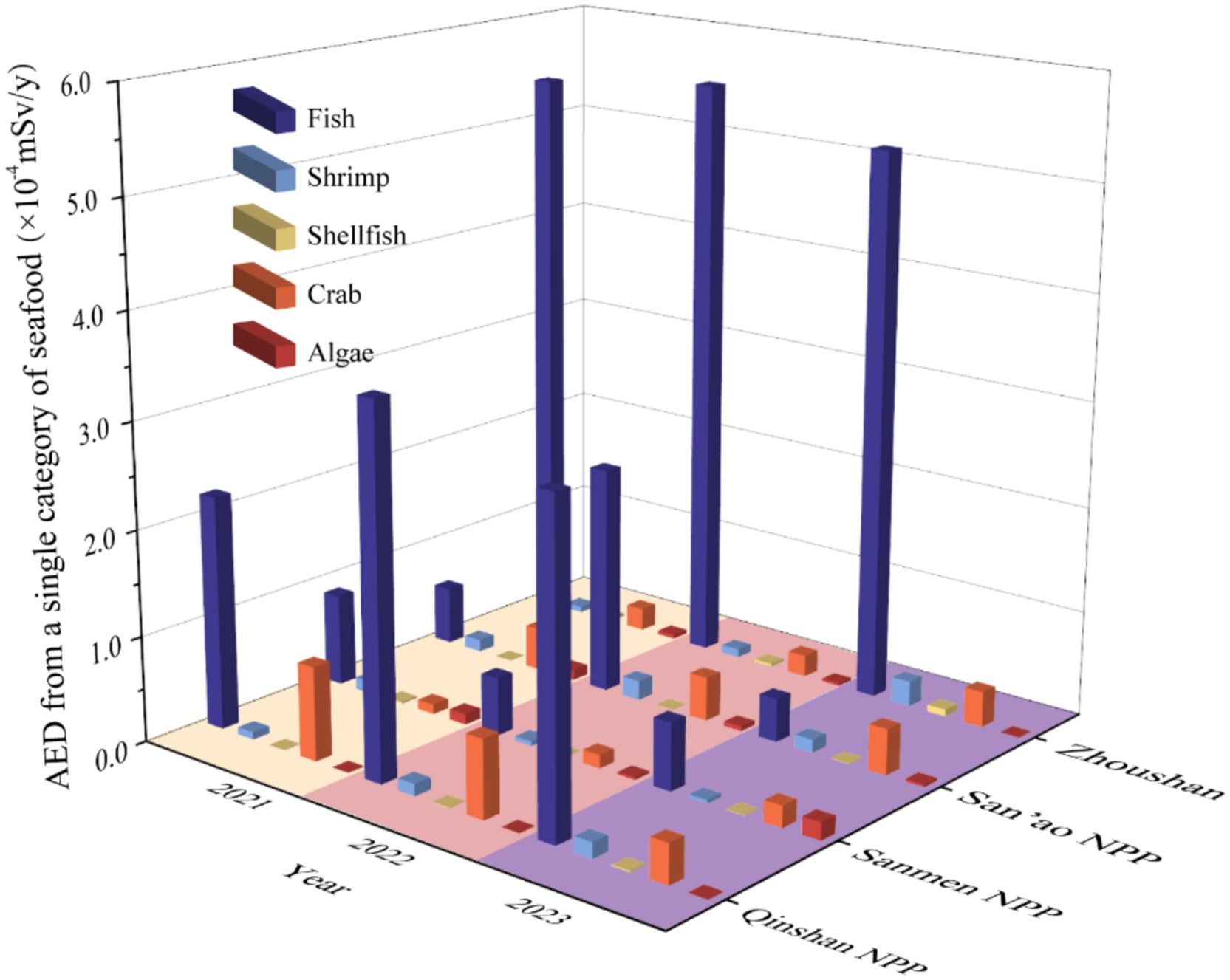
Figure 5. The AED from a single category of seafood in different NPPs and control site Zhoushan from 2021 to 2023.
4 Conclusion
The specific activities of 90Sr in seafood from three NPPs and the control site Zhoushan were monitored from 2021 to 2023. The results showed that the specific activities of 90Sr in seafood was at background levels for the period 2021–2023, which were at the same level as the results of domestic and international studies, and well below the food safety limit. The specific activity of 90Sr was found to be significantly higher in fish and crab than in the other three types of seafood. From the monitoring of seafood from three NPPs, it can be found that the 90Sr specific activities of seafood around each NPP fluctuate normally within the background level and are close to Zhoushan. There was no significant inter-annual variation in the levels of 90Sr radioactivity in the five types of seafood during the three-year period, and that the results exhibited a tendency toward stability and no statistically significant difference (p > 0.05). Additionally, the AED values associated with seafood consumption near the three NPPs and in Zhoushan are significantly lower than the acceptable standard of 1.0 mSv/year. This study addresses the scarcity of research on 90Sr specific activities in seafood around NPPs. By monitoring the 90Sr levels in seafood, we established baseline data that provides a solid foundation for evaluating nuclear power plant operations and safeguards food safety for provincial residents.
Data availability statement
The original contributions presented in the study are included in the article/supplementary material, further inquiries can be directed to the corresponding author.
Author contributions
LZ: Investigation, Writing – original draft. RW: Data curation, Writing – original draft. HZ: Writing – review & editing, Data curation, Investigation. HR: Writing – review & editing. PW: Writing – review & editing, Data curation. SY: Writing – review & editing, Supervision. ZL: Writing – review & editing, Investigation. YC: Funding acquisition, Writing – review & editing, Supervision.
Funding
The author(s) declare that financial support was received for the research and/or publication of this article. This work was funded by the Key Research and Development Plan of Zhejiang Province (No. 2024C03229), Zhejiang Health Science and Technology Plan (Nos. 2022KY130, 2022KY132, and 2023KY643), Project of South Zhejiang Institute of Radiation Medicine and Nuclear Technology (ZFY-2022-K-001 and ZFY-2022-K-006).
Conflict of interest
The authors declare that the research was conducted in the absence of any commercial or financial relationships that could be construed as a potential conflict of interest.
Generative AI statement
The authors declare that no Gen AI was used in the creation of this manuscript.
Publisher’s note
All claims expressed in this article are solely those of the authors and do not necessarily represent those of their affiliated organizations, or those of the publisher, the editors and the reviewers. Any product that may be evaluated in this article, or claim that may be made by its manufacturer, is not guaranteed or endorsed by the publisher.
References
1. Tagami, K, Fukaya, Y, Hirayama, M, and Uchida, S. Collation of strontium concentration ratios from water to aquatic biota species in freshwater and marine environments and factors affecting the ratios. Environ Sci Technol. (2021) 55:1637–49. doi: 10.1021/acs.est.0c05710
2. Povinec, PP, Hirose, K, and Aoyama, M. Radiostrontium in the Western North Pacific: characteristics, behavior, and the Fukushima impact. Environ Sci Technol. (2012) 46:10356–63. doi: 10.1021/es301997c
3. Zhang, Z, Igarashi, J, Satou, Y, Ninomiya, K, Sueki, K, and Shinohara, A. Activity of 90Sr in fallout particles collected in the difficult-to-return zone around the Fukushima Daiichi nuclear power plant. Environ Sci Technol. (2019) 53:5868–76. doi: 10.1021/acs.est.8b06769
4. Uesugi, M, Watanabe, R, Sakai, H, and Yokoyama, A. Rapid method for determination of 90Sr in seawater by liquid scintillation counting with an extractive scintillator. Talanta. (2018) 178:339–47. doi: 10.1016/j.talanta.2017.09.041
5. Konovalenko, L, Bradshaw, C, Andersson, E, Lindqvist, D, and Kautsky, U. Evaluation of factors influencing accumulation of stable Sr and Cs in lake and coastal fish. J Environ Radioact. (2016) 160:64–79. doi: 10.1016/j.jenvrad.2016.04.022
6. Miao, X, Ji, YQ, Shao, XZ, Wang, H, Sun, QF, and Su, X. Radioactivity of drinking-water in the vicinity of nuclear power plants in China based on a large-scale monitoring study. Int J Environ Res Public Health. (2013) 10:6863–72. doi: 10.3390/ijerph10126863
7. Merz, S, Shozugawa, K, and Steinhauser, G. Analysis of Japanese radionuclide monitoring data of food before and after the Fukushima nuclear accident. Environ Sci Technol. (2015) 49:2875–85. doi: 10.1021/es5057648
8. Charles, M. UNSCEAR report 2000: sources and effects of ionizing radiation. United Nations Scientific Committee on the effects of atomic radiation. J Radiol Prot. (2001) 21:83–5. doi: 10.1088/0952-4746/21/1/609
9. Shin, C, Choi, H, Kwon, HM, Jo, HJ, Kim, HJ, Yoon, HJ, et al. Determination of plutonium isotopes 238,239,240Pu and strontium 90Sr in seafood using alpha spectrometry and liquid scintillation spectrometry. J Environ Radioact. (2017) 177:151–7. doi: 10.1016/j.jenvrad.2017.06.025
10. Gupta, DK, Schulz, W, Steinhauser, G, and Walther, C. Radiostrontium transport in plants and phytoremediation. Environ Sci Pollut Res. (2018) 25:29996–30008. doi: 10.1007/s11356-018-3088-6
11. Outola, I, Saxén, RL, and Heinävaara, S. Transfer of 90Sr into fish in Finnish lakes. J Environ Radioact. (2009) 100:657–64. doi: 10.1016/j.jenvrad.2009.05.004
12. Smith, JT, Sasina, NV, Kryshev, AI, Belova, NV, and Kudelsky, AV. A review and test of predictive models for the bioaccumulation of radiostrontium in fish. J Environ Radioact. (2009) 100:950–4. doi: 10.1016/j.jenvrad.2009.07.005
13. Li, WB, Höllriegl, V, Roth, P, and Oeh, U. Influence of human biokinetics of strontium on internal ingestion dose of 90Sr and absorbed dose of 89Sr to organs and metastases. Radiat Environ Biophys. (2008) 47:225–39. doi: 10.1007/s00411-007-0154-8
14. Deng, F, and Lin, F. Measurement of 90Sr in marine biological samples. Molecules. (2022) 27:3730. doi: 10.3390/molecules27123730
15. Cao, Y, Lin, J, Zhai, K, Jiang, W, Zou, H, Ren, H, et al. Long-term investigation of environmental radioactivity levels and public health around the Qinshan nuclear power plant, China. Sci Rep. (2022) 12:4945. doi: 10.1038/s41598-022-09091-2
16. Ren, H, Yu, S, Wang, Z, Zheng, T, Zou, H, Lou, X, et al. Assessment of radiation exposure and public health before and after the operation of Sanmen nuclear power plant. Front Public Health. (2023) 11:1131739. doi: 10.3389/fpubh.2023.1131739
17. Gong, X, Ren, H, Ma, X, Wang, P, Yu, S, Zou, H, et al. Assessment of tritium and carbon-14 radioactivity levels in food and associated risks prior to the operation of San’ao nuclear power plant. Environ Technol Innovation. (2025) 37:104016. doi: 10.1016/j.eti.2025.104016
18. Pandion, K, Khalith, SBM, Ravindran, B, Chandrasekaran, M, Rajagopal, R, Alfarhan, A, et al. Potential health risk caused by heavy metal associated with seafood consumption around coastal area. Environ Pollut. (2022) 294:118553. doi: 10.1016/j.envpol.2021.118553
19. Zhang, H, Sun, C, Wang, Z, and Che, B. Seafood consumption patterns and affecting factors in urban China: a field survey from six cities. Aquacult Rep. (2021) 19:100608. doi: 10.1016/j.aqrep.2021.100608
20. Morita, T, Ohtsuka, Y, Fujimoto, K, Minamisako, Y, Iida, R, Nakamura, M, et al. Concentrations of 137Cs, 90Sr, 108m ag, 239+240 Pu and atom ratio of 240Pu/239Pu in tanner crabs, Chionoecetes japonicus and Chionoecetes opilio collected around Japan. Mar Pollut Bull. (2010) 60:2311–22. doi: 10.1016/j.marpolbul.2010.09.022
21. Men, W, Deng, F, He, J, Yu, W, Wang, F, Li, Y, et al. Radioactive impacts on nekton species in the Northwest Pacific and humans more than one year after the Fukushima nuclear accident. Ecotoxicol Environ Saf. (2017) 144:601–10. doi: 10.1016/j.ecoenv.2017.06.042
22. Sun, J, Men, W, Wang, F, and Wu, J. Activity levels of 210Po, 210Pb and other radionuclides (134Cs, 137Cs, 90Sr, 110mAg, 238U, 226Ra and 40K) in marine organisms from coastal waters adjacent to Fuqing and Ningde nuclear power plants (China) and radiation dose assessment. Front Mar Sci. (2021) 8:702124. doi: 10.3389/fmars.2021.702124
23. ICRP. The 2007 recommendations of the international commission on radiological protection, vol. 103 ICRP Publication Ann ICRP. (2007) 37:1–332. doi: 10.1016/j.icrp.2007.10.003
24. Yu, S, Cao, Y, Xuan, Z, Zhang, R, Lai, Z, Li, X, et al. Assessment of committed effective dose from ingestion of 137Cs in seafood from coastal areas of Zhejiang province. Chin J Radiol Med. (2019) 39:697–701. doi: 10.3760/cma.j.issn.0254-5098.2019.09.011
25. The minister of health of the People's Republic of China, limited concentrations of radioactive materials in foods. GB14882–94. Beijing: Standards Press of China (1994).
26. Kim, SH, Lee, H, Lee, SH, and Kim, I. Distribution and accumulation of artificial radionuclides in marine products around Korean peninsula. Mar Pollut Bull. (2019) 146:521–31. doi: 10.1016/j.marpolbul.2019.06.082
27. Hurtado-Bermudez, S, Valencia, J, Rivera-Silva, J, Mas, J, Aparicio, I, Santos, J, et al. Levels of radionuclide concentrations in benthic invertebrate species from the Balearic Islands, Western Mediterranean, during 2012-2018. Mar Pollut Bull. (2019) 149:110519. doi: 10.1016/j.marpolbul.2019.110519
28. Lee, SH, Oh, JS, Lee, KB, Lee, JM, Hwang, SH, Lee, MK, et al. Evaluation of abundance of artificial radionuclides in food products in South Korea and sources. J Environ Radioact. (2018) 184-185:46–52. doi: 10.1016/j.jenvrad.2018.01.008
29. Tan, K, Cai, X, Tan, K, and Kwan, KY. A review of natural and anthropogenic radionuclide pollution in marine bivalves. Sci Total Environ. (2023) 896:165030. doi: 10.1016/j.scitotenv.2023.165030
30. Kryshev, A. 90Sr in fish: a review of data and possible model approach. Sci Total Environ. (2006) 370:182–9. doi: 10.1016/j.scitotenv.2006.06.003
31. Yu, X. Bioaccumulative characteristics and risk assessment of typical pollutants in main kinds of fishes from Zhoushan sea area. Phd thesis. Zhejiang University (2020). doi: 10.27461/d.cnki.gzjdx.2020.004204
32. Zhang, X, Cai, L, Yu, M, and Tang, R. Study on the typical environmental factors in the middle part of Zhoushan fishery based on HY-1C/D and other multi-source data. Water. (2024) 16:1387. doi: 10.3390/w16101387
33. Cao, Y, Zhao, Z, Wang, P, Yu, S, Lai, Z, Zhang, M, et al. Long-term variation of 90Sr and 137Cs in environmental and food samples around Qinshan nuclear power plant, China. Sci Rep. (2021) 11:20903. doi: 10.1038/s41598-021-00114-y
34. Wang, P, Yu, S, Zou, H, Lou, X, Ren, H, Zhou, L, et al. Levels, sources, variations, and human health risk assessment of 90Sr and 137Cs in water and food around Sanmen nuclear power plant (China) from 2011 to 2020. Front Public Health. (2023) 11:1136623. doi: 10.3389/fpubh.2023.1136623
35. Wang, P, Wang, R, Zou, H, Lou, X, Ren, H, Zhou, L, et al. Investigation of environmental radioactivity levels and human health risk around San'ao nuclear power plant (China) before operation. Environ Technol Innovation. (2023) 32:103451. doi: 10.1016/j.eti.2023.103451
36. Panov, AV, Isamov, NN, Tsygvintsev, PN, Geshel, IV, and Sidorova, EV. Radiation monitoring of foodstuffs and drinking water in the vicinity of the Rooppur nuclear power plant (People's Republic of Bangladesh). J Food Compos Anal. (2022) 114:104732. doi: 10.1016/j.jfca.2022.104732
37. Morita, T, Fujimoto, K, Kasai, H, Yamada, H, and Nishiuchi, K. Temporal variations of 90Sr and 137Cs concentrations and the 137Cs/90Sr activity ratio in marine brown algae, Undaria pinnatifida and Laminaria longissima, collected in coastal areas of Japan. J Environ Monit. (2010) 12:1179–86. doi: 10.1039/b920173d
38. Nonova, T, and Tosheva, Z. 90Sr, 210Pb, 210Po and Ra isotopes in marine macroalgae and mussel Mytilus galloprovincialis from the Bulgarian Black Sea zone. J Radioanal Nucl Chem. (2015) 307:1183–94. doi: 10.1007/s10967-015-4502-x
39. Johansen, MP, Gwynn, JP, Carpenter, JG, Charmasson, S, Mori, A, Orr, B, et al. Which radionuclides contribute most to seafood ingestion dose? J Environ Radioact. (2025) 287:107706. doi: 10.1016/j.jenvrad.2025.107706
40. Alonso-Hernandez, C, Diaz-Asencio, M, Munos-Caravaca, A, Suarez-Morell, E, and Avila-Moreno, R. 137Cs and 210Po dose assessment from marine food in Cienfuegos Bay (Cuba). J Environ Radioact. (2002) 61:203–11. doi: 10.1016/s0265-931x(01)00127-8
Keywords: 90Sr, seafood, nuclear power plant, Zhejiang Province, risk assessment
Citation: Zhou L, Wang R, Zou H, Ren H, Wang P, Yu S, Lai Z and Cao Y (2025) Evaluating 90Sr contamination in seafood and human exposure risks near Zhejiang nuclear power plants, China. Front. Public Health. 13:1635278. doi: 10.3389/fpubh.2025.1635278
Edited by:
Antoaneta Ene, Dunarea de Jos University, RomaniaReviewed by:
Hesham M. H. Zakaly, Ural Federal University, RussiaHamdy Awad, Al-Azhar University, Egypt
Octavian G. Duliu, University of Bucharest, Romania
Copyright © 2025 Zhou, Wang, Zou, Ren, Wang, Yu, Lai and Cao. This is an open-access article distributed under the terms of the Creative Commons Attribution License (CC BY). The use, distribution or reproduction in other forums is permitted, provided the original author(s) and the copyright owner(s) are credited and that the original publication in this journal is cited, in accordance with accepted academic practice. No use, distribution or reproduction is permitted which does not comply with these terms.
*Correspondence: Yiyao Cao, eXljYW9AY2RjLnpqLmNu
†These authors have contributed equally to this work
 Lei Zhou
Lei Zhou Rui Wang1,2†
Rui Wang1,2† Hua Zou
Hua Zou Hong Ren
Hong Ren Peng Wang
Peng Wang Yiyao Cao
Yiyao Cao